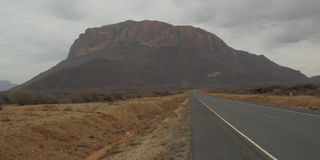Hiking in Samburu Ndoto Mountains

MT oL LOLOKWE past Samburu National Reserve to the northern Kenya. Photo | Rupi Mangat
What you need to know:
- The mountains loom large over Ngurunit, the Samburu village halfway between Samburu National Reserve and Loiyangalani on Turkana’s south-eastern shores
From Samburu National Reserve, the mountains of the north open up. The black tarmac road looks like its heading straight into Ol Lolokwe, the iconic bread-shaped mountain and after that, the long stretch of the Mathews Range. Camels and goats browse on the thorn-filled acacias. All the major rivers are now dry sand beds. The turn on the newly tarmac road dubbed the ‘wind power road’ points left to Ngurunit in the Ndoto Mountains.
The mountains loom large over Ngurunit, the Samburu village halfway between Samburu National Reserve and Loiyangalani on Turkana’s south-eastern shores. The river that gives its name to the village has run dry. In the late afternoon, Mabesi the Samburu herder and I stroll in the dry riverbed strewn with boulders. Women and children collect water in their yellow ‘debes’ from the wells dug out and then roll the drums home. The wells for people are protected with thorn fences to keep the livestock away. A scarecrow with a bright red shirt stands in a shamba. “The elephants have been around looking for food and water. The scarecrow is to frighten them away,” tells Mabesi. The drought is forcing the elephants and other wildlife to search for water and pasture, close to villages.

Samburu herds girl at the waterpool in Ndoto Mountains. Photo | Rupi Mangat
The August night sky blazes with the Milky Way, etching the mountains in the darkness. Samburu morans sing in the night, their voices carried in the pure silence of the desert.
The camel bells passing by Salato Camp awaken us. The sun will soon heat the day, so the herders with their camels hurry to the pastures while the children take their goats up into the mountains. We follow suit to the water pools hidden in the sky forest.
The thorn fenced homesteads with the huts thin out as we begin climbing. David Lekuye, my Samburu guide stops at the gigantic sausage tree on his ancestral land where his parents are buried. He bows down to place his offering of tobacco to them, a touching moment.

The water pool in Ndoto Mountains. Photo | Rupi Mangat
The path gets narrower and steeper with more forest. “The kids make noise to let the chui (leopards) know they are around,” continues Lekuye. These tiny children who look no older than seven roam the mountains, at ease in their world. I can’t image a seven-year-old city bred child being able to handle this world.
Up close, the mountains reveal their many facets – the flat top of Lepurri hill, an enclave and further away, the sacred Mt. Poi with its bare cliff. We meet a Samburu moran in his colourful beaded jewellery walking down the mountains and stop to chat.
“We’re getting closer to the water,” announces Lekuye. By now l’m hot and tired. The sound of water is music to my ears. Stepping past a towering obelix, the world opens to a deep rift towered over by the flat-topped mountain with its bare cliff face. It looks like a mini Table Mountain.
It’s the Ngurunit River again – this time in the mountains. It’s at a low flow, barely running over the grey granite boulders unlike when at full flow, it cascades like a waterfall over the gigantic rocks. In the midday heat, swimming in the shallow pool is refreshing, surrounded by the mountains. The guide splashes water on the ‘slide’, a steep granite slope for the children to slide down into the pool. A little Samburu girl in her red beads and draped in her shuka at the waist arrives from the higher mountain path with her goats. While they quench their thirst, she walks into the pool, swims to the opposite end and clambers up the rocks like a mountain goat. I’m envious.
We enjoy a picnic. The stronger ones hike up to the higher pools and summit the ‘Table Mountain’. There’s more water up there. Later in the afternoon, we meet back at the camp run by Salato, the group of local Samburu and Rendille women.
Vanishing Wildlife
Until the 1970s, there were elephants, giraffes, zebra, buffaloes and lions around Ngurunit because it was a watering point for the pastoral Samburu as the river never dried. But once the permanent water hole and tap were built by the missionaries, the Samburu and Rendille settled with their livestock.
Stay at Salato
For contact, email Laura Lemunyete: [email protected] or seeFacebook – https://web.facebook.com/Salato-Campsite-430814374333592/
It’s a basic camp with four bandas, each with two beds by the river. The ground is spacious for camping. Fresh water is accessible but it’s better to carry drinking water. Carry a cooler box with food supplies for the nights you plan to stay. The camp has a basic kitchen with a gas cooker and utensils.
Hikers will love the many hiking trails up the mountains or leisurely strolls on the plains. It’s hot so carry sun-protective gear.
www.rupitheafricantrotter.com
For feedback write to the editor on [email protected]




